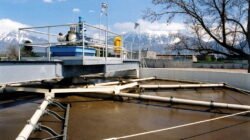Commercial PFAS Water Treatment
Commercial PFAS Water Treatment: Addressing a Growing Environmental Challenge
Introduction
In recent years, per- and polyfluoroalkyl substances (PFAS) have garnered significant attention due to their pervasive presence in drinking water supplies and the increasing regulatory scrutiny surrounding them. As industries grapple with the implications of PFAS contamination, commercial water treatment solutions have emerged as a vital linchpin in safeguarding public health and environmental integrity. This article delves into the multifaceted domain of commercial PFAS water treatment, providing water treatment professionals, municipal directors, and design engineers with comprehensive insights into effective strategies, technologies, and regulatory frameworks.
Understanding PFAS and Their Implications
What Are PFAS?
PFAS, often referred to as "forever chemicals," encompass a broad group of synthetic compounds used in various applications, including firefighting foam, waterproofing agents, and pharmaceuticals. Their chemical stability and resistance to degradation raise concerns about long-term environmental impact and human health risks.
Key Properties:
- Persistence: Many PFAS compounds can persist in the environment for decades.
- Bioaccumulation: They accumulate in the human body and wildlife, leading to adverse health effects, including liver damage and reproductive issues.
Health and Environmental Risks
According to the U.S. Environmental Protection Agency (EPA), exposure to certain PFAS may lead to a variety of health concerns, prompting mandates for stringent exposure limits. Reports indicate that nearly 200 million Americans may be exposed to PFAS in drinking water.
Regulatory Landscape
National Initiatives
As of 2025, the regulatory framework in the U.S. and abroad has become increasingly stringent. Key regulations influencing commercial PFAS water treatment include:
- EPA Maximum Contaminant Levels (MCLs): Recent guidance has established enforceable limits for specific PFAS compounds in drinking water, pushing states to develop compliance frameworks.
- State-Level Regulations: Many states have enacted their own PFAS regulations, heightening the need for effective treatment solutions.
- International Standards: The European Union has initiated discussions around chemical safety regulations, potentially affecting import/export scenarios for PFAS-containing products.
The Commercial Water Treatment Challenge
Existing Treatment Technologies
The pressing question facing municipal directors and engineers simmers down to a single challenge: How to effectively treat water contaminated with PFAS? Below, we analyze existing technologies and their suitability for commercial applications.
Activated Carbon Filtration
- Overview: A widely used method, activated carbon adsorbs PFAS as water passes through it.
- Effectiveness: Generally effective for long-chain PFAS but less so for short-chain variants.
- Costs: Initial setup is relatively low, but frequent replacement adds lifecycle costs.
Ion Exchange Resins
- Overview: Ion exchange processes involve resin beads that capture PFAS ions as water flows through.
- Effectiveness: Highly effective in removing various types of PFAS, including short-chain compounds.
- Costs: Higher initial investment but lower operational costs over time due to longer service life.
Reverse Osmosis
- Overview: This method forces water through a membrane that allows only H2O molecules to pass, effectively filtering out PFAS compounds.
- Effectiveness: High removal rates, but energy-intensive and may produce significant wastewater.
- Costs: Higher operational costs, making it less favorable for large-scale initiatives.
Advanced Oxidation Processes (AOP)
- Overview: AOP techniques involve the generation of hydroxyl radicals to break down PFAS.
- Effectiveness: Innovative but still largely experimental and not yet widely adopted.
- Costs: Significant capital investment and operational complexity.
Emerging Solutions
Nanotechnology in Water Treatment
Recent studies indicate that nanomaterials offer promising solutions for PFAS treatment, with unique properties for targeted adsorption and degradation. Companies developing nanotechnology applications are making strides toward next-generation commercial PFAS treatment.
Bioremediation Approaches
While still in nascent stages, researchers are exploring the potential of certain bacteria in degrading PFAS compounds. This biological approach could offer a sustainable path forward, particularly in specific environmental settings.
Case Studies: Successful Implementation
Case Study 1: Municipal Treatment Facility
In 2024, a municipal treatment facility in Michigan installed an ion exchange system specifically designed for PFAS removal, resulting in a 99% reduction in PFAS concentrations. The initiative was supported by state funding aimed at improving water quality, showcasing a collaborative approach towards regulatory compliance.
Case Study 2: Industry Response
A manufacturing plant faced regulatory pressure to address PFAS discharge into local water bodies. By integrating advanced oxidation processes alongside traditional filtration methods, the facility reduced PFAS outputs by over 80%, signaling a proactive response to regulatory compliance and reputational risk management.
Economic Considerations
Cost-Benefit Analysis
When evaluating commercial PFAS water treatment systems, decision-makers must consider initial costs, operational expenses, and long-term sustainability. Detailed cost-benefit analyses should factor in potential fines for noncompliance, public health impacts, and community expectations.
Funding Opportunities
As of 2025, various federal and state programs offer financial support to municipalities and industries aiming to implement PFAS treatment solutions. Leveraging these opportunities can offset initial investments and foster community trust.
Conclusion
The landscape of commercial PFAS water treatment is evolving, influenced by regulatory developments and advancements in treatment technologies. As a senior environmental engineer, it is clear that a multifaceted approach—incorporating a range of technologies and a strong regulatory framework—is essential for effective PFAS management. By staying informed and adaptable, water treatment professionals can navigate the complexities of this issue, contributing to the health and safety of communities nationwide. As we move forward, collaboration between industry, regulators, and technology developers will be pivotal in overcoming the PFAS challenge for a cleaner tomorrow.


